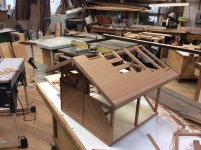itchy said:I don't know how some woodworkers are able to get by without the use of a table saw, I'm intruiged I'd love to have more insight into their workflow. I can see the benefit of space saving with a track saw but I can not see how you can be as productive doing tasks typically done at the table saw. I don't think a table saw takes up that much space and at the very least it can double as another work surface and we all know that can be invaluable. I'm not suggesting a tracksaw can't achieve the same outcome as a table saw just that it can't do it as productively.
I'm sure that, if you build furniture or do carpentry work for a living, then productivity is most likely the number one consideration along with tool quality. However, for me, woodworking is a hobby and productivity is not the number one consideration as woodworking is something I do to create and sometimes build things I need. Actually table saws themselves don't take up a huge amount of space. It's the space that is required around them that is difficult to dedicate. Plus, in my case, to get a good cabinet saw into my basement workshop would be extremely difficult. I bought an 8" jointer a few years ago and knew then that moving a large 300-400 table saw into my basement was not going to happen. That is why I am thinking about a "job site" saw and, if the new Sawstop is high quality and good at dust collection the price is worth the portability without losing quality. I wouldn't disagree that, for some things, a table saw is better. However, since I sold my old one (never a good saw), I have found that using the bandsaw and jointer to rip smaller pieces is possible as well as ripping some with the TS55 and MFT. Ripping, for me, is the toughest without a table saw.


